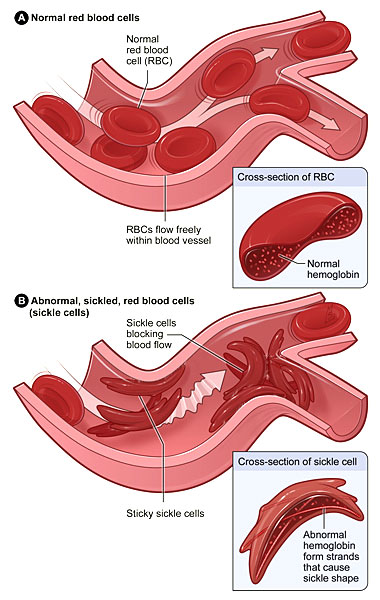Top > FAQ's
FAQ's
What Is Sickle Cell Anemia?
Sickle Cell Anemia is a blood disorder that causes anemia (shortage of red blood cells) and periodic pain. In people with sickle cell anemia, not all of their hemoglobin (a molecule in red blood cells that carries oxygen to other parts of the body) works properly. Some of the hemoglobin forms long, rod-like structures that cause the red blood cells to be sickle-shaped and stiff.
These cells can clog small blood vessels, preventing some organs or tissues from receiving enough oxygen. When this happens, it can cause episodes of severe pain or damage organs and tissues, and may lead to other serious medical problems.

What are the Complications?
Complications from the sickle cells blocking blood flow and early breaking apart include:
- Pain episodes
- Strokes
- Increased infections
- Leg ulcers
- Bone damage
- Yellow eyes or jaundice
- Early gallstones
- Lung blockage
- Kidney damage and loss of body water in urine
- Painful erections in men (priapism)
- Blood blockage in the spleen or liver (sequestration)
- Eye damage
- Low red blood cell counts (anemia)
- Delayed growth
What Causes Sickle Cell Anemia?
Sickle cell anemia is caused by an error in the gene that tells the body how to make hemoglobin. The defective gene tells the body to make the abnormal hemoglobin that results in deformed red blood cells. Children who inherit copies of the defective gene from both parents will have sickle cell anemia. Children who inherit the defective sickle hemoglobin gene from only one parent will not have the disease, but will carry the sickle cell trait. Individuals with sickle cell trait generally have no symptoms, but they can pass the sickle hemoglobin gene on to their children.
The error in the hemoglobin gene results from a genetic mutation that occurred many thousands of years ago in people in parts of Africa, the Mediterranean basin, the Middle East, and India. A deadly form of malaria was very common at that time, and malaria epidemics caused the death of great numbers of people.
Studies show that in areas where malaria was a problem, children who inherited one sickle hemoglobin gene and who, therefore, carried the sickle cell trait - had a survival advantage. Unlike the children who had normal hemoglobin genes, they survived the malaria epidemics they grew up, had their own children, and passed on the gene- for sickle hemoglobin.
As populations migrated, the sickle cell-mutation spread to other Mediterranean areas, further into the Middle East and eventually into the Western Hemisphere. In the United States and other countries where malaria is not a problem, the sickle hemoglobin gene no longer provides a survival advantage. Instead, it may be a serious threat to the carrier's children, who may inherit two abnormal sickle hemoglobin genes and have sickle cell anemia.
What is Sickle Cell Trait?
Sickle cell trait is a person who carries one sickle hemoglobin producing gene inherited from their parents and one normal hemoglobin gene. Normal hemoglobin is called type A. Sickle hemoglobin called S. Sickle cell trait is the presence of hemoglobin AS on the hemoglobin electrophoresis. This will NOT cause sickle cell disease. Other hemoglobin traits common in the United States are AC and AE traits.
How Many People Have Sickle Cell Disease?
Sickle cell disease is a global health problem. In the United States it is estimated that over 70,000 people have sickle cell disease. About 1,000 babies are born with the disease each year in America.
Is There a Test for Sickle Cell Disease or Trait?
Yes. A person can have a blood test to find out if he has either sickle cell trait or a form of the disease. There also are prenatal tests to find out if the baby will have the disease or carry the trait. If both parents have the sickle cell trait, in three out of four cases, the prenatal test will show that the baby will not have sickle cell disease.
Is Sickle Cell Only In African Americans?
Sickle cell is in many nationalities including African Americans, Africans, Arabs, Greeks, Italians, Latin Americans, and those from India. You can be Caucasian and have sickle cell disease or trait. All races should be screened for this hemoglobin at birth.
Can a Woman with Sickle Cell Disease Have a Safe Pregnancy?
Yes. However, women with sickle cell disease are at increased risk of complications that can affect their health and that of their babies. During pregnancy, the disease may become more severe and pain episodes may occur more frequently. A pregnant woman with sickle cell disease is at increased risk of preterm and of having a low-birthweight baby.
However, with early prenatal care and careful monitoring throughout pregnancy, women with sickle cell disease can have a healthy pregnancy. If the baby's father has sickle cell trait, the baby has a 50 percent chance of having the disease. If he does not, the baby will have only the trait.
.png)



